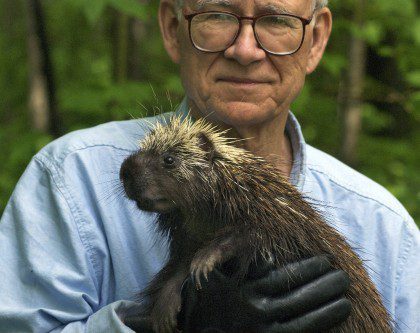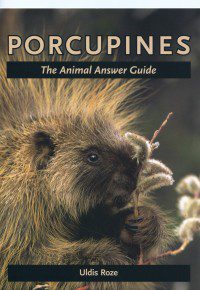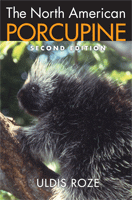
Dr. Uldis Roze
Dr. Uldis Roze
Professor Emeritus
Ph.D. (Washington University)
E-mail: uldis.roze@verizon.net
Research interests:
I have been interested in the anatomy, ecology, and natural history of the North American porcupine, Erethizon dorsatum. Erethizon is in many ways an atypical representative of the New World porcupines, the Erethizontidae. Its species range is very large and extends far beyond the tropics. Its body size is the largest of any erethizontid. Its diet includes tree bark to a greater extent than shown by any other erethizontid. Its tail lacks prehensile function and functions instead as a powerful quill-delivery system.
Recently, in collaboratiuon with Drs. Gaston Gine of the Univ. Estaduel de Santa Cruz, Brazil, and David Chapman of Lakehead University, Canada, I have become interested in the anatomy and natural history of another atypical erethizontid, the thin-spined porcupine, Chaetomys subspinosus. Chaetomys has had a long evolutionary separation from other New World porcupines and belongs to its own sub-family, the Chaetomyinae. It is the only New World porcupine with quills that lack one-way barbs. Its range is restricted to the Atlantic Forest of southeastern Brazil, and because this forest has been 92% destroyed, Chaetomys may be the most endangered of the New World porcupines.
Selected Publications:
2023. David M. Chapman, Gastón Andrés Fernandez Giné, and Uldis Roze. Functional histology of the integument of the thin-spined porcupine, Chaetomys subspinosus. Can. J. Zool. 101(7): 1–10. URL
2019. D.M. Chapman, G.A.F. Gine, and U. Roze. Microscopy and development of a remarkable pitted quill from the thin-spined porcupine, Chaetomys subspinosus. Can. J. Zool. 97(1): 31-41. PDF
2018. J. O Whitaker, Jr. and U. Roze. Invertebrates from porcupine (Erethizon dorsatum) rock dens from Greene County, Catskill Mountains, New York. Proc. Indiana Acad. Sci. 127(2): 124-127. PDF
2012. U. Roze. Porcupines, the Animal Answer Guide. Johns Hopkins University Press, Baltimore. 204 pp. See http://jhupressblog.com/


2010. U. Roze, K.T. Leung, EW. Nix, G. Burton, and D.M. Chapman 2010. Microanatomy and bacterial flora of the perineal glands of the North American porcupine. Can. J. Zool. 88:59-68. PDF
2009. U. Roze. The North American Porcupine, 2nd Ed., 288 pp. Cornell U. Press, Ithaca. Information Here
2006. U. Roze. Smart Weapons. Natural History 115 (March): 48-53. PDF
2004. U. Roze. Risk factors for injury in porcupines. Wildlife Rehabilitation 21: 61-63.
2003. U. Roze and L. M. Isle. Porcupine. p.p. 371-380 in: Wild Mammals of North America: Biology, Management, and Conservation. Second Edition, George A. Feldhamer, Bruce C. Thompson, and Joseph A. Chapman, Editors. Johns Hopkins University Press, Baltimore and London.
2002. U. Roze. A facilitated release mechanism for quills of the North American porcupine (Erethizon dorsatum). J. Mammalogy, 83(2):381-385.
1997 G. Li, U. Roze, and D.C. Locke. Warning odor of the North American porcupine (Erethizon dorsatum). J. Chem. Ecol. 23: 2737-2754.
1997 D.M. Chapman and U. Roze. Functional histology of quill erection in the porcupine, Erethizon dorsatum.Can. J. Zool. 75:1-10.
1990 U. Roze, D.C. Locke, and N. Vatakis. Antibiotic properties of porcupine quills. J. Chemical Ecology, 16:725-734.
1989 U. Roze. The North American Porcupine. Smithsonian Inst. Press, Washington, D.C., 261 pp.
U. Roze and J.L. Strominger l966. Alanine racemase from S. aureus and its competitive inhibition by D-cycloserine. Molecular Pharmacology 2: 92-94.

